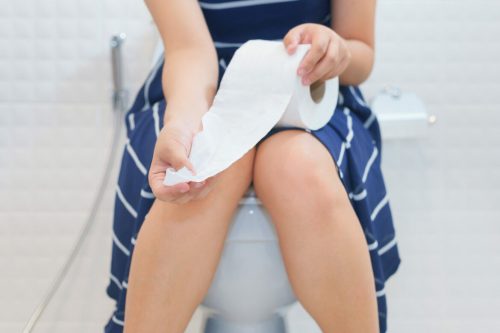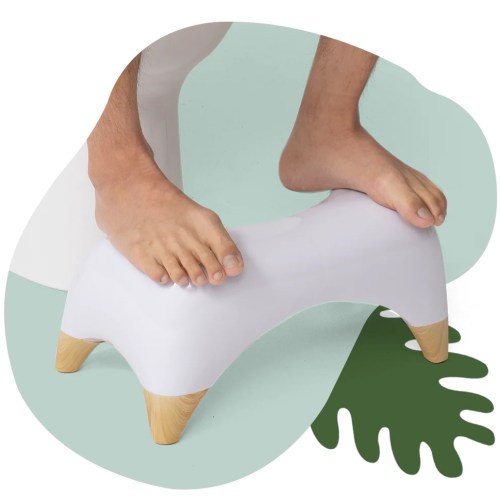Our editors independently select these products. Making a purchase through our links may earn Well+Good a commission
How To Sit on the Toilet With Proper Posture, According to a Pelvic Floor Therapist
We talked to a pelvic floor physical therapist on how to sit on the toilet for optimal bladder health. Chances are, you're doing it wrong!

Sitting properly when you’re on the toilet to do your business is just as consequential as, say, sitting up straight at your desk. Alicia Jeffrey-Thomas, PT, DPT, a pelvic floor physical therapist, says learning how to sit on the toilet with proper posture can promote bladder health and help your stream come more easily (no, really).
Experts in This Article
urology and women’s health specialist at Aeroflow Urology
doctor of physical therapy, owner of Femina Physical Therapy, and author of Sex Without Pain
Joyce Rockwood is a certified colon hydrotherapist and gut health expert.
board-certified urologist, female urology specialist, and associate professor in the Department of Urology at University of Texas Southwestern Medical Center
How To Sit on the Toilet Properly
“The proper position should be to fully sit with the knees slightly elevated. This opens up the angle of the pelvic floor muscles, opening the pelvic diaphragm,” says Maude Carmel, MD, an associate professor in the department of urology at UT Southwestern Medical Center. “This will make the evacuation of the bladder and rectum much easier. Common mistakes are squatting position and not fully sitting on the toilet.”
Below, you’ll find a handful of tips for how to sit on the toilet, because there is such a thing as good posture when you pee and poop.
1. Never hover over the toilet—sit down.
When you’re using a public bathroom, you may opt for squatting over sitting. Dr. Jeffrey-Thomas wants you to fight that urge (even if it means toilet-papering the seat beforehand). According to the doc (who posted a video demonstrating proper toilet posture on TikTok), your pelvic floor can’t fully relax if you’re hovering just above the seat. Sit down, and let it flow, because this is the best way to empty your bladder.
2. Use a toilet stool if you have one.
“The worst position to be in while you’re on the toilet is with your feet on the floor,” colon hydrotherapist Joyce Rockwood tells Well+Good. “You should be simulating a squatting posture so your puborecatalis muscle opens and the bowel movement can drop out of the body. When you have your feet off the ground, you’ll notice how easy it is to eliminate.” It also helps if you’re just urinating.
Additionally, Heather Jeffcoat, DPT, owner of Femina Physical Therapy in Los Angeles and current president of the Academy of Pelvic Health Physical Therapy, recommends that you always have your thighs in contact with the toilet seat. If you have a toilet stool you can prop your feet on, all the better, as this improves the anorectal angle, making bowel movements easier to pass, she adds.

Tushy Ottoman Premium Toilet Stool — $69.00
ThirdLove Just Launched Bras That Help Balance Your Body Temperature—Here’s Why That’s a Game-Changer for Women in All Life Stages

These Are the Only Types of Underwear You Should Be Wearing, According to Gynecologists

These Are the Summer Essentials You Should Bring With You Every Time You Leave the House, According to a Derm and an RD

3. Sit up straight while you’re on the throne.
I know you want to curl over your phone and scroll through Instagram—but now is just not the time. Sit up straight so that your pelvic floor will naturally engage while you’re in the bathroom. Dr. Jeffcoat stresses that this is the proper way to sit on the toilet because you want your body to be at the best angle to empty your bowels and bladder.
4. Do not push to pee.
If you’re trying to make your pee break as fast as possible, you may want to push, push, push—but that’s actually not great for your pelvic floor in the long-run. “A healthy bladder works best if the body just relaxes so that the bladder muscles naturally contract to let the urine flow, rather than using the abdominal muscles to bear down as with a bowel movement,” according to Yale Medicine. If you’re impatient waiting for all that to happen naturally, Dr. Jeffrey-Thomas says you can put your elbows on your knees and circles your torso around to help the pelvic floor relax.
Why is sitting on the toilet correctly important?
It’s totally normal and common to run into a less than clean toilet seat. Even though wanting to squat over a toilet seat so that you don’t have to touch it makes sense, experts like Dr. Carmel and Dr. Jeffcoat stress that you plant your tush firmly on the seat. Definitely pack wipes or wipe the seat down with a paper towel if you need to; we’ve all been there. But, having a proper seated position is essential for fully evacuating your bladder.
The muscles that you use to hover over a toilet seat are the same muscles that you engage to stop peeing, according to Dr. Jeffcoat. This means that when you squat over a seat to try and pee—you are engaging both the part of your pelvic floor that makes you pee and the part that gets you to stop. This can cause some pelvic floor tightness over time and also potentially prevent you from empyting your bladder. This can put you at risk for urinary tract infections or urgency down the road. Knowing how to sit on the toilet in the best way for your bladder can keep those at bay.
How does your posture outside the bathroom affect your body in the bathroom?
“Slouched posture can affect your lower back and pelvis alignment and can put more stress on the pelvic floor muscles,” says Dr. Carmel. When you have more stress on these muscles, it can cause them to be overly tight or too weak. When this happens, Dr. Carmel explains that patients with pelvic floor dysfunction have frequently increased urinary frequency, urgency and difficulty voiding, and sensation of incomplete emptying.
How to Improve Your Posture and Strengthen Your Pelvic Floor
Having strong abdominals, glutes, and groin muscles is important for supported posture both inside and out of the restroom, according to Aleece Fosnight, MSPAS, PA-C, a women’s health and urology specialist of Aeroflow Urology. Stretching, postural best practices, and strength training all benefit your pelvic floor and how you go to the bathroom. Practicing light strength moves, strengthening your body all over, and practicing good posture as you sit, stand, and walk are all important.
If you have so much stiffness or dysfunction in your lower spine and/or hips that do not allow you to flex these areas, it could prevent you from getting into the aforementioned ideal posture, Dr. Jeffcoat says. This doesn’t mean that one would not ever be able to empty fully, but if they have pelvic floor dysfunction, it is a contributing factor that their pelvic floor physical therapist could explore with them.
When it comes to posture, though, it seems like everyone has some memory of a teacher, parent, or babysitter telling them to sit up straight or complaining that they were a sloucher. At the end of the day, however, knowing how to sit on the toilet properly can help your overall health in the bathroom and outside of it.
Sign up for the Well+Good SHOP Newsletter
Get exclusive deals on wellness, beauty, fitness, and food products that have been hand-picked by our editors.
Got it, you've been added to our email list.







